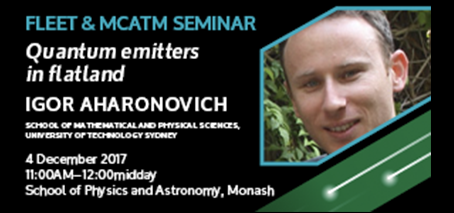-
FLEET RESEARCH SEMINAR
4 Dec 2017
11:00 am - 12:00 pm
IGOR AHARONOVICH
School of Mathematical and Physical Sciences, University of Technology Sydney
Proudly brought to you by FLEET and MCATM. All welcome. Event Flyer can be downloaded here.
Abstract:
Engineering solid state quantum systems is amongst grand challenges in engineering quantum information processing systems. While several 3D systems (such as diamond, silicon carbide, zinc oxide) have been thoroughly studied, solid state emitters in two dimensional (2D) materials have not been observed. 2D materials are becoming major players in modern nanophotonics technologies and engineering quantum emitters in these systems is a vital goal.
In this talk I will discuss the recently discovered single photon emitters in 2D hexagonal boron nitride (hBN). I will present several avenues to engineer these emitters in large exfoliated sheets using ion and electron beam techniques. I will also discuss potential atomistic structures of the defects supported by density functional theory.
The formed emitters in 2D hBN flakes have extremely promising properties – including high brightness (~ millions counts/s), stability up to high temperatuers and linear polarization at excitation and absorption. Those properties make these emitters extremely attractive for their integration with optical resonators and waveguides.
I will show preliminary results on plasmonic enhancement and integration with nanophotonics resonators. Finally, I will discuss several challenges and promising directions in the field of quantum emitters and nanophotonics with 2D materials and other wide band gap materials.
About the Speaker:
A/Prof. Igor Aharonovich received his PhD in 2011 from the University of Melbourne where he developed experimental techniques to engineer novel, ultra bright single photon emitters in diamond.
After which, he took a postdoctoral position at Harvard University with Prof Evelyn Hu focusing on the nanofabrication of optical cavities out of diamond, SiC and GaN. He also carried out nanophotonic experiments including coupling of emitters to optical cavities, turning of cavity resonances and low temperature high resolution spectroscopy.
His current research interests are surrounding wide bandgap semiconductors and their implementation in Nanophotonics and Bio-sensing.
Venue: Seminar Room 110, School of Physics and Astronomy
Address:

